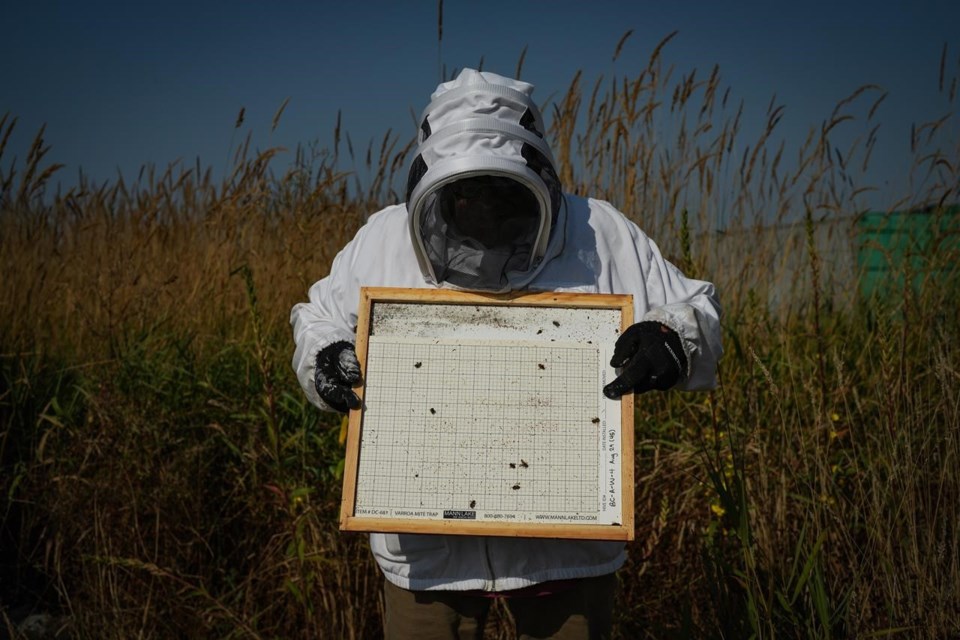SURREY, B.C. — Chemistry professor Erika Plettner gestures towards beehives surrounded by tall, dry grasses as she explains the multiple pressures facing honeybees worldwide.
Pesticides, pathogens and the effects of climate change are putting bees and their role as pollinators of the world's food crops in peril, she says.
So Plettner and her team of researchers are working towards mitigating one tiny yet deadly risk factor — the varroa mite.
The team at Simon Fraser University in British Columbia's Lower Mainland is testing a chemical compound that appears to kill the mites without harming the bees, in hopes it could one day be widely available as a treatment for infested hives.
Varroa mites kill bees by puncturing their cuticle, or exoskeleton, creating a wound that doesn't close, Plettner said.
That leaves an opening for disease and weakens bees' immune systems, she said in an interview at the researchers' experimental apiary outside Surrey, B.C.
"That's what then ultimately makes (the bees) collapse during wintering," she said.
Plettner and her team are testing the safety and efficacy of the compound identified in her lab some years ago, which appears to paralyze and then kill the mites.
The bees involved in the experiment fly in and out of their hives as Plettner explains that the researchers don't yet understand exactly how the compound works.
"We don't know the actual protein in the mite to which the compound binds, or a collection of proteins. We know that paralysis usually involves the nervous system of the mite," she said.
Her team recently obtained funding from Genome British Columbia, a non-profit organization, to work with researchers at the University of British Columbia to investigate how the compound affects the mites, she added.
The researchers place a sheet of sticky paper beneath the hives to collect the dead mites for analysis in their lab, she said.
So far, the chemical compound looks promising as a potential treatment alongside five or six others currently available, Plettner said.
It's important to rotate through different treatments from year to year, she said, because the mites are starting to show resistance to what she called the "gold standard" of existing treatments.
The varroa mite originally parasitized honeybees in Asia before spreading to Afro-European honeybee populations about 100 years ago, she said.
"In terms of evolutionary time, this is relatively short. And that's why our bees are so affected by this, because ... in an evolutionary sense, they haven't had a chance to develop, through selection, natural defences."
Efforts are underway to find bees that are more naturally resistant to the mites, said Plettner, noting one of her own hives at her home has had no mites this summer, while the neighbouring hive was "boiling over" with the pests.
"Every once in a while, you get a hive that is quite resistant to the mite, and this is a subject of very intensive research and bee breeding efforts."
It will take some years to commercialize the compound, making it available as a treatment, Plettner said.
The researchers still need to understand how it works and demonstrate that it's safe for bees, beekeepers and the surrounding environment, she said.
It's especially important to mitigate varroa mite infestations given the range of environmental pressures bees are facing, Plettner said.
Climate change is affecting the ecology of honeybee habitat, changing the availability of the flowers and plants they need to survive, she said.
Moreover, bees are part of a system of intensive agricultural practices that employ pesticides and herbicides across Canada and worldwide, she said.
"Even if near the apiary is not sprayed, bees will fly quite far, up to two kilometres, to seek flowering plants and food," she said. "So they can get accidentally contaminated with substances that are harmful."
At the same time, many plants that are considered weeds and targeted with herbicide by agricultural operators are important for bees, Plettner said.
This report by The Canadian Press was first published Sept. 4, 2022.
Brenna Owen, The Canadian Press




